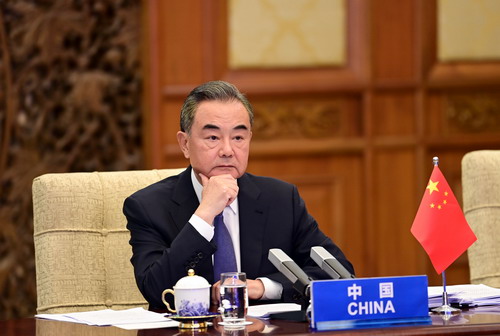


Chinese State Councilor and Foreign Minister Wang Yi attends the 10th East Asia Summit Foreign Ministers' Meeting via video link.
BEIJING, Sept. 9 (Xinhua) -- The United States has become the biggest driver of the militarization of the South China Sea and the most dangerous factor damaging peace in the area, Chinese State Councilor and Foreign Minister Wang Yi said Wednesday.
Wang made the remarks while attending the 10th East Asia Summit Foreign Ministers' Meeting via video link. He said that the United States has directly intervened in territorial and maritime disputes in the region out of its own political needs, constantly flaunting its force and strengthening its military deployment. It is becoming the biggest driver of the militarization of the South China Sea.
The United States has interfered with the efforts of China and Association of Southeast Asian Nations (ASEAN) countries to resolve disputes through consultation, as well as provoking confrontation between countries in the region. It is becoming the most dangerous factor damaging peace in the South China Sea, said Wang.
"Peace and stability are China's greatest strategic interest in the South China Sea," Wang said, adding that it is also the common strategic aspiration of China and ASEAN countries.
"China hopes that countries outside the region, including the United States, will fully respect the wishes and expectations of countries in the region, instead of creating tension and seeking profit from it."

 Award-winning photos show poverty reduction achievements in NE China's Jilin province
Award-winning photos show poverty reduction achievements in NE China's Jilin province People dance to greet advent of New Year in Ameiqituo Town, Guizhou
People dance to greet advent of New Year in Ameiqituo Town, Guizhou Fire brigade in Shanghai holds group wedding
Fire brigade in Shanghai holds group wedding Tourists enjoy ice sculptures in Datan Town, north China
Tourists enjoy ice sculptures in Datan Town, north China Sunset scenery of Dayan Pagoda in Xi'an
Sunset scenery of Dayan Pagoda in Xi'an Tourists have fun at scenic spot in Nanlong Town, NW China
Tourists have fun at scenic spot in Nanlong Town, NW China Harbin attracts tourists by making best use of ice in winter
Harbin attracts tourists by making best use of ice in winter In pics: FIS Alpine Ski Women's World Cup Slalom
In pics: FIS Alpine Ski Women's World Cup Slalom Black-necked cranes rest at reservoir in Lhunzhub County, Lhasa
Black-necked cranes rest at reservoir in Lhunzhub County, Lhasa China's FAST telescope will be available to foreign scientists in April
China's FAST telescope will be available to foreign scientists in April